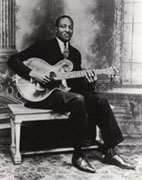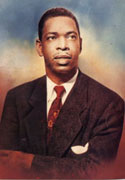|
 |
 |
|
|
|
chicago blues
|
What is now referred to as the "classic Chicago style"
was developed in the late 1940s and early 1950s, taking Delta blues,
amplifying it and putting it into a small-band context. Adding drums,
bass, and piano (sometimes saxophones) to the basic string band and
harmonica aggregation, the genre created the now standard blues band
lineup. The form was (and is) flexible to accommodate singers,
guitarists, pianists and harmonica players as the featured performer in
front of the standard instrumentation. Later permutations of the style
took place in the late 1950s and early 60s with new blood taking their
cue from the lead guitar work of B.B.King and T-Bone Walker, creating
the popular West Side sub genre which usually featured a horn section
appended to the basic rhythm section. Although the form embraced rock
beats and modern funk rhythms in the '80s and '90s, it has since
generally stayed within the guidelines developed in the 1950s and early
60s.
Quote from Cub Koda at All-Media
Guide.
|

Big
Bill Broonzy
|

Buddy
Guy
|

Elmore
James
|
When large groups of blacks migrated north
from the Mississippi and Louisiana Delta region, many went to Chicago
and brought with them their music, called the Delta Blues. Like
everything else, their music changed after being in the big city and it
emerged as the Chicago Blues. By the 1930s, Chicago Blues were very
popular and this popularity grew in the '40s and '50s.
Chicago Blues is high-spirited music that adds harmonica to guitar and
keyboard, drumbeat, and later electric guitar and bass for a more
powerful and sophisticated sound than its more low-key Delta cousin.
Chicago Blues are hard-edged and loud because Chicago is
a hard-edged, tough industrial city in which you have to be more
powerful and louder in order to be heard.
Some well-known
musicians who play or have played the Chicago Blues are B.B. King,
Junior Wells, Howlin' Wolf, and Muddy Waters.
Quote from
Knowledge Adventure.
|
|
Hawlin' Wolf
|
Memphis Slim
|
Muddy Waters
|
|
CHICAGO is the blues capitol of the world — a musical
metropolis filled with the electrified sounds of snarling guitars,
howlin' vocals, and big city rhythms. Striking a chord with Chicago
audiences in the 1930's, the Chicago blues sound has continued to hold
listeners firmly by the ears to this very day.
Quote from A Chicago Blues Tour at Big Chicago
Record
|
|
Robert Nighthawk
|
Sunny Boy Williamson II
|
Tempa Red
|
|
|
|
|
